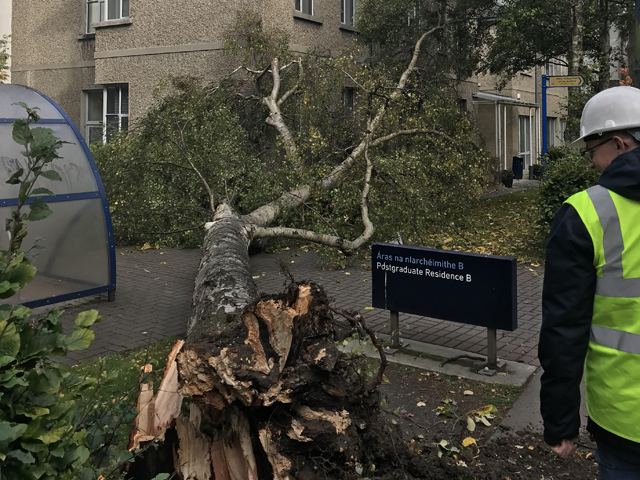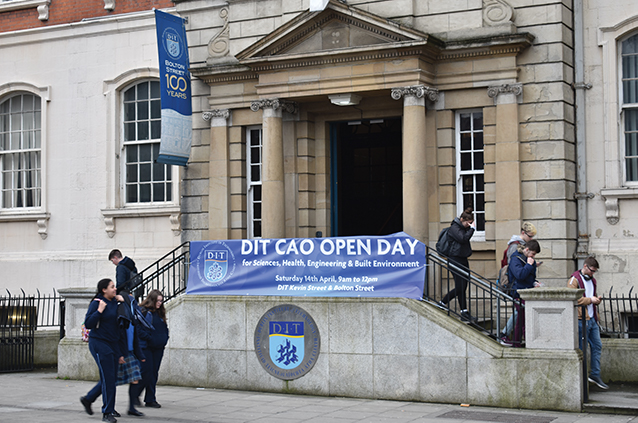
[dropcap]T[/dropcap]here was minor damage to a building and two trees down across the three campuses in DCU after hurricane Ophelia passed through Dublin on Monday.
A tree fell and hit the side of the Bea Orpen building near the postgraduate residences on the Glasnevin campus, damaging part of the roof and gutting. The tree appeared to be rotten at the roots.
“We got off very lightly but we were prepared for a lot worse,” said Declan Raftery, Chief operations officer at DCU.
“We were expecting worse, the size the campus is and with the older trees we were expecting a lot of trees down,” he added.
The main Ballymun road entrance to the college was blocked off from Sunday night due to the hazard of broken or fallen branches.
“A fair few sizeable branches came down and if you’re in the wrong place at the wrong time on that road it could injure you. It’s gorgeous to look at, but in high winds we’re like close the Ballymun road,” said Raftery.
Raftery said he had been tracking the storm since last Wednesday to be properly prepared for a shut-down. A team of 30 maintenance workers was on standby, as well as extra water pumps and plywood in case there were windows smashed or broken.
He worked with the president of DCU to address the situation.
“Myself and Brian (MacCraith) talked and we triggered the team to come in at seven thirty in the morning because the winds were only picking up from lunchtime in the Dublin area. We were in here all day, from seven until seven.”
On Sunday afternoon the first of four email communications was sent by Raftery and his team to the staff and students of DCU warning the severe weather alert. When the storm escalated, another update sent at 8.50 pm stated that the campus would be closed on Monday. At ten o’clock another email clarified that all campuses were closed from 11 pm Sunday to 11 pm Monday.
The university reopened for normal services at 7 am Tuesday morning, and academic activities, lectures, laboratory classes, for students re-commenced at 2 pm.
“We said we couldn’t justify closing it for the full day, so we decided to start academic lectures at 2 so that everyone had a chance to get going, not stressing people to get up at 7 and try and get up. There are always people who can’t get up but they’d only miss half a day of lectures, so we thought it was a reasonable compromise. It also gave us a bit of breathing space for the honorary degrees as well.”
The Helix was open on Tuesday morning to host the awarding of honorary doctorates to Bill Clinton, Sr. Stanislaus Kennedy and Dr. Martin Naughton, KBE.
“We were tracking the loss of power that could have threatened the honorary degree ceremony but thankfully they didn’t. We had clean up crews out at 5 in the morning to try and get things back to normal but it worked out,” said Raftery.
“The active construction sites were also a concern, as well as the crane and scaffolding which could have caused damage during the storm. We liaised with the two construction sites on site, they locked down all their loose equipment to try to minimise the amount of material that could fly away in the wind.”
Raftery’s main concern was the electricity.
“We have very limited emergency backup power, we have it for our IT systems, some of the buildings. We don’t have the backup power to run the university, we’ve never had the funding to do it. Power outage is a real problem, loss of power would mean we’d have to close, we’ve no choice.”
Raftery said that the major emergency plan triggered for the “bizarre” storm was a very rare event.
“17,000 students and 1200 staff its nearly the size of Kilkenny, 1400 people live here, it’s a town in itself. So we did a lot of work this year on new major emergency planning in place and a lot of support infrastructure around that and technology to help us to react to whatever comes at us,” he added.
Fionnuala Walsh



